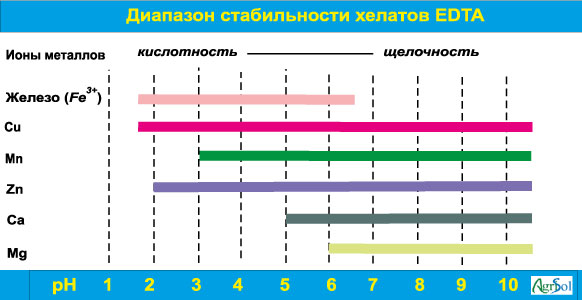When grown on soil in a nutrient solution prepared on the basis of simple salts (magnesium sulfate, potassium sulfate, calcium and potassium nitrate, monopotassium phosphate, magnesium nitrate), usually do not include microelements. This is due to the fact that most of them are present in some amount in the ground, zinc comes with irrigation water passing through galvanized pipes, and molybdenum and copper are often included in plant protection products. The only microelement that must be regularly monitored and applied with top dressing is boron. Nevertheless, plants often suffer from the so-called “hidden” deficiency of certain micronutrients, i.e. from their inaccessibility to plants.
Moving in the tissues of most trace elements, as well as calcium occurs with an upward flow of water. Therefore, a decrease in transpiration leads to the fact that microelements and calcium can not reach the top of plants or fruits. This is where the signs of a deficit usually appear. Thus, the appearance of dome-shaped tops in the initial period of cultivation, when the plant is still inactive, is associated with insufficient intake of calcium and boron to these parts of plants. Vertex rot of tomato and pepper is caused by insufficient intake of calcium into the apex of the fetus when the microclimate is broken (excessive or insufficient air humidity, increased or lowered temperature). Prevent such deficiencies by optimizing the temperature and humidity in the greenhouse. If it is impossible to maintain the required parameters, regular foliar fertilizing (every 7-10 days) with boron and calcium-containing fertilizers (Brexil Ca and Boroplus) is performed.
The optimum soil pH values for growing vegetables and fruit crops are in the range from 5.8 to 6.2. It is in this interval of soil acidity that plants best absorb all macro- and microelements. Strong acidification of the soil leads to an increase in the solubility of manganese, iron and aluminum, which causes damage to the root system of plants.
When the pH is raised, plant-important trace elements such as iron, zinc and copper form insoluble compounds (hydroxides) that precipitate and can not be absorbed by plants. Also on alkaline soils the solubility of phosphorus and boron decreases sharply. In these cases, it is necessary to optimize the pH of the substrate and carry out foliar top dressing. Thus, prolonged watering with water above pH 7.0 leads to alkalization of the soil and a decrease in the availability of these trace elements. As a result, plants experience their deficiency and lose part of the crop. In addition, the resistance of plants to stresses and pathogens is reduced.
Another important factor is the observance of the optimal ratio of nutrients in the substrate for a given culture. With an excess of phosphorus, zinc and iron precipitate in the form of phosphates that are inaccessible to plants. The shortage of these trace elements is often observed in plants grown on soils with a high content of phosphorus. It is known that zinc is an antagonist of iron, i.e. The excess of zinc ions in the soil solution disrupts the intake of iron into the plants. Therefore, with increased zinc content in irrigation water, it is recommended to increase the application of iron by 20-30%.
Thus, in order to prevent the emergence of a “hidden” micronutrient deficiency, it is necessary to create the best conditions for the development of the root system, in particular to maintain the optimum pH value and the ratio of nutrients in the substrate and ground.
To solve this problem, the company Valagro created a series of microfertilizers using organic chelating agents EDTA.
The latter bind metal ions to high-strength organometallic complexes – chelates, completely eliminating the formation of an insoluble precipitate. Helat firmly retains the ion until it enters the plant and absorbs it.
The main purpose of the chelating agents is to maintain the micronutrients in the forms available to the plant.At the same time, they have a number of other important advantages, for example, they are not destroyed by soil microorganisms.
Chelating agents significantly increase the solubility of micronutrients, thereby facilitating their movement to the root surface and assimilation by plants even in strongly alkaline calcareous soils.
Accordingly, the easier the assimilation of micronutrients by a plant, the faster and the restoration of the latter from a state of nutritional deficiency. And since the plant completely absorbs all the microelements introduced into the soil, the expenditure necessary to fill the deficit is less than when using the salts of these elements.

The use of chelates Zn, Mn, Cu instead of the salts currently used will increase the efficiency of not only the above microelements, but also the iron chelate DTPA introduced with them.
The Valadrol EDTA microfertilizers can be applied either directly to the soil (substrate) for root uptake, or by a non-root method. Chelates are compatible with fertilizers and various types of plant protection products. The most effective method of application should be selected depending on the specific conditions, in particular the pH level of the soil or culture medium.
Chelated micronutrients often act more efficiently than microelements from inorganic compounds. The reason for this is that chelates not only ensure the availability of nutrient micro elements, but also facilitate the absorption of microelements by leaves.
Naturally, you first need to determine exactly whether the microelements present in the soil are not sufficiently accessible to plants, for which it is necessary to perform a chemical analysis of local soils. The true state of plants can only be assessed with the help of tissue analysis.

PACKAGING – Bags weighing 1 and 5 kg.
APPLICATION:
Fertigation:

Foliar top dressing:

Attention! Do not exceed the concentration of 100 g of Valagro EDTA fertilizers per 100 liters of water.

